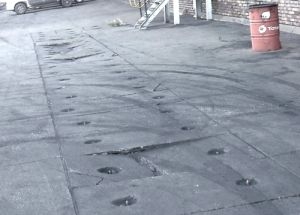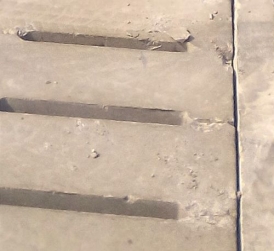- Paving
- Electrical Engineering and Telecoms Infrastructure
- Civil Engineering, Mining, Railway, Building and Plumbing Products
- Curbs / Kerbs
- Landscaping, Streetscaping, Gardening products
- Moulds
- Pizza Oven Kit
- Avalon range
- Builders' and Plumbers' Products
- Benches and Seats
- Concrete Tables
- Grass Blocks
- Litter/Refuse Bins
- Pots and planters (Discontinued)
- Tree rings
- Bollards and Barriers
- Stone Cellar Blocks
- Water features (Discontinued)
PROBLEMS WITH CONCRETE AND STEEL GRID COVERS OVER STORMWATER CHANNELS
Common Problems experienced with Concrete Grid Covers over Stormwater Channels:
When a heavy vehicle drives over a Grid Cover, the resulting bending moment causes a large tensile stress in the bottom fibres at midspan. The tensile strength of concrete is low and it has to be reinforced with steel. On short span covers, shear breaking is also possible. For both bending and shear, the thicker the Grid Cover, the better. The problem is not the concrete but the designer who does not use sufficient thickness or reinforcing steel.
Under-design:
Covers may in the vast majority of cases only carry pedestrians or occasional light vehicles. Bearing cost in mind, the covers are often designed for those loadings only. However, a single event of a heavy vehicle wheel on the cover will break it. The designer or specifier must allow for the worst possible case.

Concrete is more brittle than steel. This means it has a propensity for breaking under repeated high impact loading. An example is a cover installed in a busy roadway. For such cases, special cognizance has to be taken of dynamic loading and fatigue.
Dog Bone Trouble:
| A popular Grid Cover is the so called "Dog Bone" trench cover. It is a rectangular cover with narrowings on either long side towards the middle. When laid side-by-side the narrowings form slits through which the water can flow. Although this seems to be good idea, when it comes to wheel loading it is the worst kind of trench cover. | |
 |
At midspan where more concrete is needed, there is less. In the manufacturing of the casting mould, to include a chamfer all along the top edge is very difficult and expensive. Top edges are therefore made 90° unchamfered. This leaves the top edge vulnerable to chipping. A minimum cover over reinforcing steel of at least 30mm for moist conditions is specified and necessary. Corners and edges are thus unreinforced for 30x30mm. This exacerbates chipping, which often exposes the reinforcing. The reinforcing starts to rust, which leads to spalling and further corrosion. It is even worse for the four top corners where reinforcing from the narrower middle part is continued straight through leaving even larger unreinforced corners. |
 Freshly chipped concrete Freshly chipped concrete |
Dog Bone Trench Covers that are damaged by heavy vehicle wheel scoffing |
Problems with Steel And Cast Iron Grid Covers:
Traffic bearing grid covers have to be very strong. Even though steel and cast iron grids are heavy, it is lighter than concrete and easily lifted. Because of the amount of ferrous metal available and its recycle value, such items are readily stolen.
Steel grids, unless properly galvanised will rust.
Metal grids are equally subject to under-design as is the case with concrete.
Polymer Concrete Grids
Polymer concrete has 2 - 3 times better tensile strength than unreinforced cement concrete but is 10 times more expensive. On the other hand steel is 10 times stronger than polymer concrete but is only twice as expensive. The economy does not work.
Its only advantage is that it has no scrap value.

